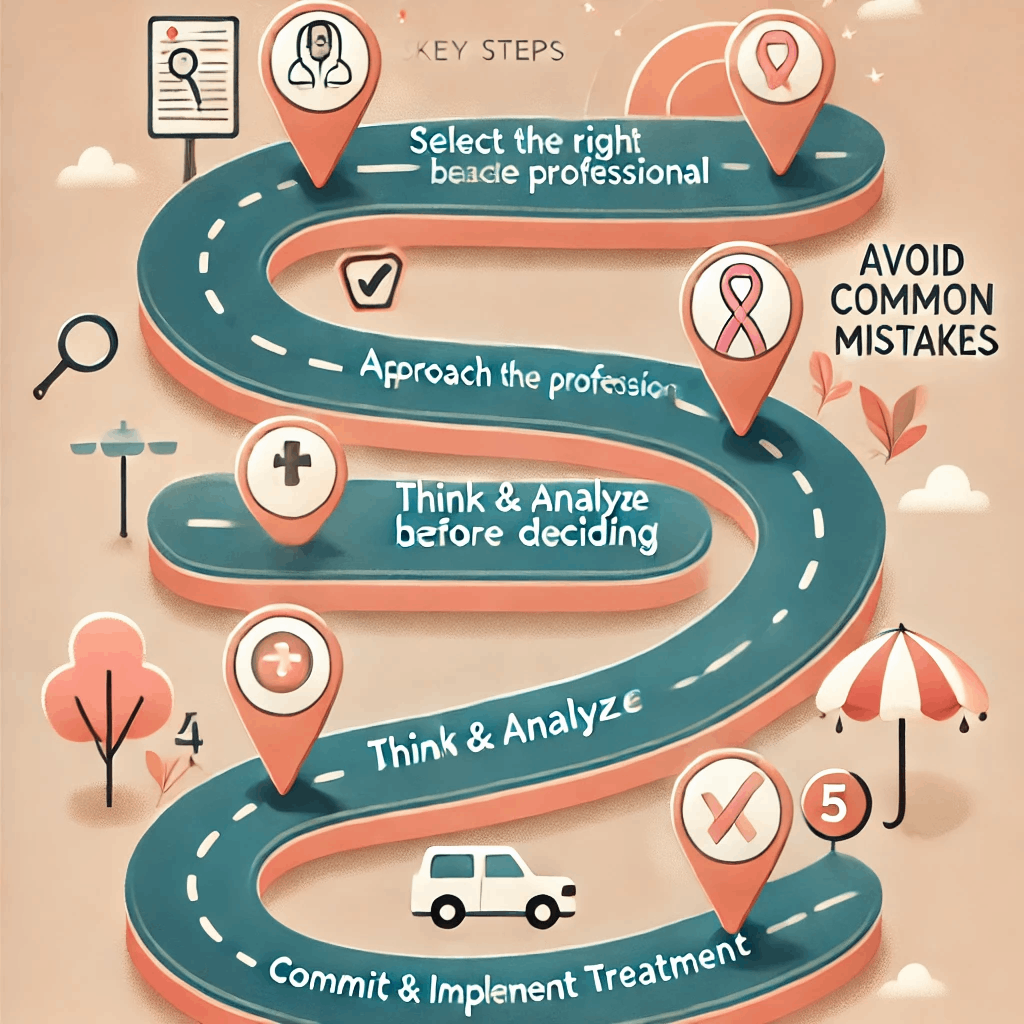Confused about where to start your vaginismus treatment? Worried about making the wrong decision? You’re not alone! Many couples struggle with choosing the right approach—and most make crucial mistakes that delay their recovery. The key to success is making the right decision, following a structured plan, and committing fully to the process. This guide will walk you through 5 essential steps to select the best treatment, avoid common pitfalls, and achieve lasting results. Let’s break it down—step by step!
Step 1: Select the Professional
The first and most crucial step in any healthcare or rehabilitation journey is selecting the right professional. This decision significantly impacts the success of treatment, recovery, and overall well-being.
When choosing a professional, consider the following factors:
- Expertise and Qualifications – Ensure that the professional has the necessary educational background, certifications, and licenses in their field. For example, if you’re looking for a physiotherapist, check if they have specialized training in musculoskeletal therapy, sports rehabilitation, or pelvic health, depending on your needs.
- Experience in the Relevant Field – The more experience a professional has in treating a specific condition, the better they are at diagnosing and managing it. Look for someone who has handled cases similar to yours.
- Success Rate – One of the most important factors to consider is the professional’s success rate in treating conditions like yours. Ask about their past outcomes, patient recovery statistics, and long-term effectiveness of their treatments. A high success rate indicates a well-proven approach and expertise in delivering positive results.
- Reputation and Reviews – Seek recommendations from friends, family, or online reviews. A professional with a strong track record of success is more likely to provide quality care.
- Communication and Approachability – A good professional listens to your concerns, explains treatment plans in an understandable manner, and makes you feel comfortable throughout the process.
- Scientific Treatment Approach – The professional should follow a well-researched and evidence-based treatment approach rather than relying on trial and error. They should provide a clear plan outlining how the treatment works and why it is effective. The methods used should be backed by scientific studies and proven to be beneficial for similar conditions.
- Defined Number of Sessions – The professional should be able to give you a realistic estimate of the number of sessions required to overcome your issue. While adjustments may be needed based on progress, they should provide a structured treatment plan rather than leaving it open-ended. This helps set clear expectations and track improvement.
- Proper Explanation of Treatment Benefits – The professional should clearly explain how their treatment approach will help you recover. They should describe how each technique or exercise contributes to healing, strengthening, or pain relief. Understanding the “why” behind each step of your treatment increases confidence and adherence to the plan.
- Availability and Accessibility – Consider the location of the professional’s clinic, appointment availability, and whether they offer online consultations if needed.
- Cost and Insurance Coverage – If cost is a factor, check whether the professional’s services are covered by insurance or if they offer flexible payment options.
By selecting a professional who follows a structured, scientific approach with clear explanations and a defined treatment plan, you can ensure a more effective and predictable recovery

Step 2: Approach the Selected Professional
Once you have selected the right professional based on their expertise, experience, success rate, and treatment approach, the next step is to approach them effectively. Proper communication and preparation can ensure a smooth and productive consultation.
1. Book an Appointment
- Contact the professional’s clinic via phone, email, or an online booking system to schedule a consultation.
- Check their availability and choose a convenient time. If they have a waiting period, book in advance to secure your spot.
- If they offer online consultations, inquire about the process and technical requirements.
2. Prepare Your Medical History
- Gather any previous medical reports, X-rays, MRI scans, or other diagnostic tests related to your condition.
- Make a list of past treatments you have tried and their outcomes.
- Note down any medications you are currently taking.
3. Clearly Define Your Problem
- Before the appointment, reflect on your symptoms:
- What are you experiencing (pain, stiffness, weakness, restricted movement, etc.)?
- When did it start?
- What makes it better or worse?
- How is it affecting your daily activities?
- Being clear and precise about your condition helps the professional assess your case efficiently.
4. Discuss Expectations and Goals
- Explain what you aim to achieve from the treatment.
- Ask about the expected recovery timeline and the number of sessions required.
5. Inquire About the Treatment Plan
- Request a structured, evidence-based treatment plan instead of a vague, trial-and-error approach.
- Ask the professional to explain how their methods work and why they are effective for your condition.
- Ensure they outline a clear step-by-step recovery process, including exercises, therapies, or lifestyle modifications needed.
6. Clarify Logistics and Financial Aspects
- Confirm session frequency, duration, and follow-up appointments.
- Ask about fees, package options, and insurance coverage.
- Inquire about cancellation policies and rescheduling options.
7. Assess Their Communication and Comfort Level
- A good professional should listen attentively, answer your questions clearly, and make you feel confident in the treatment.
- If you feel rushed or that your concerns are not being addressed, reconsider whether they are the right fit for you.
8. Commit to the Treatment Plan
- If you feel comfortable with the professional’s approach, follow their instructions diligently.
- Stay consistent with the prescribed exercises and lifestyle recommendations to maximize recovery.
Approaching a professional with proper preparation and clear expectations ensures you get the best possible treatment and a well-structured recovery plan.

Step 3: Logical Thinking and Decision-Making – Take Your Time
After the initial consultation with the selected professional, it’s essential to take a step back and analyze all the information before making a decision. Avoid rushing into treatment without thoroughly assessing whether the approach aligns with your needs and expectations.
1. Review the Information Gathered
- Reflect on the details provided by the professional during the consultation.
- Key aspects to consider:
- Diagnosis – Was the professional able to accurately diagnose your issue?
- Success Rate – Did they provide real evidence of their treatment effectiveness?
- Treatment Plan – Is the approach structured, scientific, and clear?
- Expected Recovery Time – Did they provide an estimated number of sessions required?
- Explanation of Treatment Methods – Did they explain how and why their approach will help?
2. Discuss as a Couple
- If this decision involves both partners (such as for vaginismus treatment or other couple-related issues), sit down and discuss:
- Did both of you feel comfortable with the professional?
- Are you confident in their knowledge and ability to help?
- Does the treatment approach align with your expectations and lifestyle?
- It’s crucial that both partners feel heard, understood, and supported in the process.
3. Assess Your Comfort Level with the Professional
- A professional’s expertise is important, but so is their communication style and approachability.
- Ask yourselves:
- Did they listen to your concerns and answer all questions clearly?
- Did they provide reassurance and confidence in the treatment?
- Were they open to addressing doubts or customizing the plan if needed?
- If you felt rushed, unheard, or uncertain, it may be a sign to reconsider.
4. Compare Options If Needed
- If you’re not entirely convinced, it’s okay to seek a second opinion from another professional.
- Comparing treatment approaches from different experts can help validate the best course of action.
5. Consider Practical Aspects
- Think about:
- Session Frequency & Commitment – Are you able to follow through with the recommended sessions?
- Financial Investment – Does the cost fit within your budget?
- Time & Travel – Is the location convenient, or do they offer online options?
6. Make an Informed Decision
- Once you and your partner have carefully analyzed all factors, make a confident decision.
- If you decide to proceed, commit to the plan with a positive and open mindset.
- If something doesn’t feel right, don’t hesitate to explore other professionals or treatment options.
Taking your time to logically evaluate all aspects ensures that you make the best choice for a successful recovery.

Step 4: Common Mistakes Couples Make While Making a Decision
Making the right decision about treatment is crucial, but many couples unknowingly make mistakes that can delay or even prevent successful recovery. The most common mistake is prioritizing convenience over results, which can lead to ineffective treatment choices.
1. Choosing Comfort Over Effectiveness
- Many couples prefer a treatment approach that fits their lifestyle, work schedule, or location rather than what is actually required to overcome the issue.
- They often say things like:
- “Can we do the treatment online?”
- “We don’t have time for in-person sessions.”
- “We want something that doesn’t interfere with our routine.”
- Reality Check: Physical issues like vaginismus cannot be treated effectively through online consultations alone. While online guidance can provide education and emotional support, the actual treatment requires hands-on physiotherapy, guided exercises, and real-time feedback—which is only possible in person.
2. Making Excuses Instead of Prioritizing Health
- Couples often delay or modify treatment plans due to:
- Work commitments
- Travel inconvenience
- Family responsibilities
- Fear or hesitation
- Reality Check: These are modifiable factors, meaning they can be adjusted. Your condition, however, will not improve unless you take the right steps. If left untreated, vaginismus can cause long-term emotional distress and impact your relationship.
3. Expecting a One-Size-Fits-All Solution
- Some couples expect a general approach rather than a customized treatment plan.
- They may compare their case with others and assume:
- “Someone else got better with just a few exercises; why can’t we do the same?”
- “Can’t we just follow a generic online program?”
- Reality Check: Every case of vaginismus is different. The severity, underlying causes, and response to treatment vary from person to person. Treatment should be tailored to your specific condition, not based on what worked for someone else.
4. Not Trusting the Professional’s Expertise
- Couples sometimes challenge the professional’s recommendations because they don’t align with their personal preferences.
- They might:
- Doubt the number of sessions required.
- Expect quicker results without following the complete plan.
- Try to self-diagnose or modify exercises on their own.
- Reality Check: If you’ve chosen a professional based on their expertise and success rate, trust their guidance. Skipping or modifying sessions based on your assumptions can lead to incomplete recovery or relapse.
5. Delaying Treatment Due to Fear or Embarrassment
- Some couples hesitate to start treatment due to fear of discomfort, embarrassment, or social stigma.
- Reality Check: The longer you wait, the more difficult it becomes to overcome the condition. Seeking timely, professional help is the most empowering step you can take toward a fulfilling relationship.
How to Take the Right Decision?
✅ Base your decision on what will help you overcome the issue—not on what is easiest or most convenient.
✅ Follow a structured, evidence-based treatment plan recommended by a professional.
✅ Understand that physical treatments require physical intervention. Online-only approaches are not a substitute for real treatment.
✅ Adjust modifiable factors like work, travel, and schedules to prioritize your health.
✅ Commit fully and follow through with the treatment plan without unnecessary delays.
Final Thought
Taking the right decision is a crucial part of vaginismus treatment. It’s normal to feel hesitant, but don’t let convenience, fear, or external factors dictate your recovery. Choose what’s effective, not just what’s easy, and you will see real, lasting results.

Step 5: Commit to the Treatment & Implement All Techniques
Once you and your partner have made the decision, the next and most important step is taking action. Simply deciding is not enough—you must fully commit, implement all techniques, and prioritize the treatment sessions. If you follow the plan as advised by the professional, you will definitely achieve results.
1. Start the Treatment Without Delays
- Once you’ve decided, begin the treatment immediately. Delaying will only prolong the problem and may make recovery harder.
- Trust the process and stay consistent with the plan laid out by your professional.
2. Implement All Techniques Correctly
- Follow every exercise, therapy, or intervention exactly as prescribed.
- Do not skip or modify any techniques based on your convenience.
- Ask for clarification if something is unclear—proper execution is crucial for progress.
3. Prioritize Your Committed Treatment Days
- Your treatment should be non-negotiable. Adjust your work, travel, and personal schedule around your treatment—not the other way around.
- Treat your sessions as appointments that cannot be missed, just like a surgery or an important medical procedure.
- Skipping or postponing sessions disrupts progress, so stay disciplined and show up every time.
4. Stay Patient and Trust the Process
- Results do not happen overnight. Healing takes time, but with consistent effort, you will see progress.
- Avoid frustration if improvement is gradual—every small step counts toward full recovery.
5. Maintain Open Communication with Your Professional
- Regularly update your professional about your progress, challenges, or doubts.
- If you feel any difficulties, discuss them immediately instead of making changes on your own.
- Follow their feedback and adjustments to optimize your results.
Final Thought
If you stay committed, implement all techniques properly, and make treatment your top priority, you WILL overcome this issue. Success is guaranteed within stipulated period, when you put in the effort consistently.


